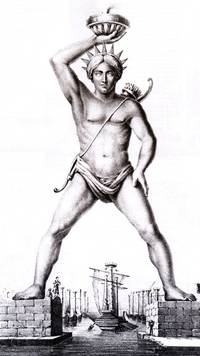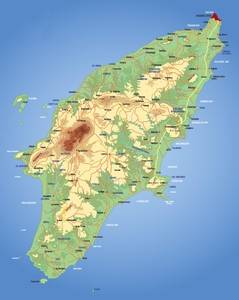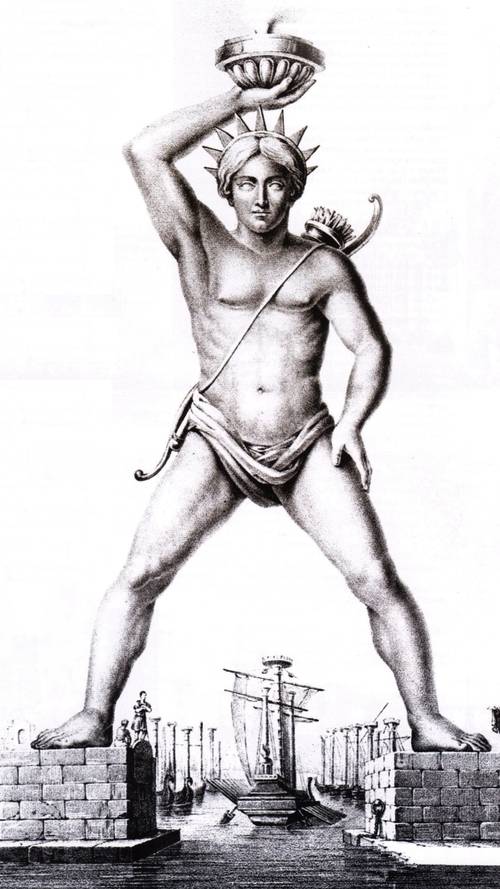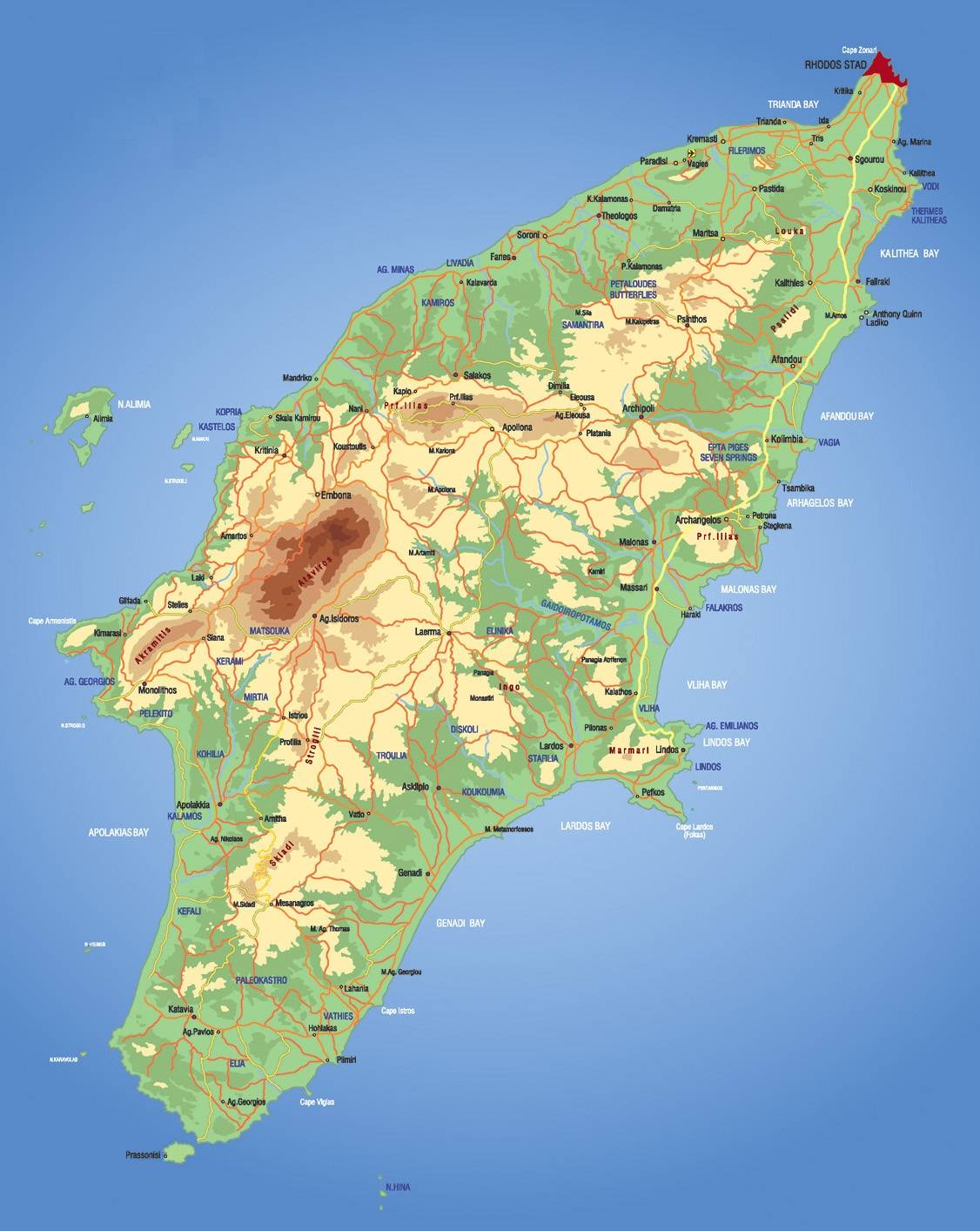
The Colossus of Rhodes
The Colossus of Rhodes is the main source of inspiration for the Statue of Liberty.
The Colossus of Rhodes was a statue of the third century BC. Destroyed nowadays, it is invariably represented as an almost naked man wearing a crown of sunlight and brandishing a torch. The analogy is striking with the Statue of Liberty, we are here in the true style of the work of Bartholdi. It measured 32m high and was made of bronze. Its construction began in 292 BC and lasted 12 years. The reasons for its construction were simple. In 304 BC the people of Rhodes (a Greek island close to Turkey, formerly independent) survived a terrible siege. It was a great cause to celebrate, because it was the third seat suffered by the island in less than 30 years. The people were so grateful that he decided to erect a huge statue to the sun god Helios, the protector of the island. The statue was built through the sale of military equipment abandoned on the ground by Demetrius Poliorcetes which with 40,000 soldiers, had led the attack on the capital of the island.
The statue stood on a marble base, at the bottom of the port of Rhodes. It was made of bronze pieces on an iron frame. Despite the great efforts of the sculptor Chares of Lindos, the Colossus stood under age 60: It was among the Seven Wonders of the World, which had the shortest life. It was unfortunately destroyed in a powerful earthquake in 226 BC. Broken at the knees, she collapsed and fell apart. The broken statue remained there until 654 AD. The Arabs, who had invaded Rhodes, sold bronze in a Syrian merchant who won on the backs of 900 camels. It remains today a trace of the colossus.
The island of Rhodes was famous for her statues, and according to Roman author Pliny, the capital was proud of owning 3000. Some were made of stone, and others, like the Colossus, bronze. Although large bronze statues were made elsewhere, such as Athena, made by Phidias, 12m high and installed in the Parthenon of Athens, none were across the Colossus.

Map of Rhodes
Rhodes is the largest Greek island in the Dodecanese. It is located about 19Km off the Turkish coast. The port in the capital, also called Rhodes, is said to be the place where the Colossus was, but nobody knows exactly. Rhodes was a city protected by a 15Km long rampart and a broad ditch, forcing the attackers to use a turn to enter the city. Dedicated to Helios, the Sun God, the city had a large temple. Some believe that the statue was situated near the temple, but the images are received we indicate it was in the harbor entrance. By cons, these representations shows a statue spanning the harbor entrance, which is physically wrong because it is such a statue would not only much more than 32 meters high, but it would have a weight that the structure would not not required. The designer of the statue was Chares of Lindos (Lindos was one of three major cities of Rhodes). He was a follower of a realistic style, chosen to magnify the realism of the statues and bring strength and movement. It is said that the face of the Colossus of Rhodes was one of Alexander the Great.
Construction of the Colossus of Rhodes
The construction of the statue had to be epic. From a wide marble base builders climbed the huge statue piece by piece. Molded parts and assemblies formed foot whose size already surpassed that of most existing statues. Heavy stone blocks were used to anchor the lower legs, which surrounded a solid iron frame to which the finest we fixed them hammered plates. Each plate was formatted before being hoisted into place and secured to adjacent parts and the iron frame. The colossus grew gradually thanks to the workers who brought much care for the work to which they were involved: build the biggest statue that has probably never existed. To complete the work, the workers had managed to polish the surface of Colossus until it shines in the sun.
The choice of the bronze was not harmless. It is an alloy of copper and iron. Stronger than iron, it is more resistant to atmospheric conditions. Therefore it is well suited to the manufacture of statues to be exposed to the outside, and particularly to the marine salt laden air. When the Colossus was finished it was very difficult to make larger than life statues in one piece. The only way to proceed was to manufacture various parts, worked or flat. An ancient text says that the Colossus included more than 13 tons of bronze, but it seems to be underestimated. The pieces worked from the base of the statue was cast in molds, flat pieces were thin sheets of hammered metal.
In practice ...
The base of the statue is stone, iron and copper. The latter was used as early as 2500 BC, it was the first metal to be exploited. It has long been used to make coins. It is largely buried in the ground. The Greeks imported their copper Cyprus. Once the work in the mine were harsh: the collapses resulted in numerous fatal accidents. The wells could reach 12m deep. The miners were working in narrow corridors if they could not stand up. The ore was brought to the surface in baskets, where it was heated to reduce copper. Then copper chips and tin blocks, called ingots, were weighed and mixed in the right proportions to make bronze. Copper was the main component for the bronze statue: It came to 80 to 90% in its composition. Once melted it flows more easily than copper, it is appropriate rather well to molding. The workers were carrying molten metal from the furnace to the mold in a huge iron spoon. Ultimately they obtained thin sheets of bronze or other thicker, to the desired shape. The mussels were clays and could be used several times. The next step was to remove rough edges and polish the plates. These plates were then made on the assembly site, where they were joined to each other by pins. The plates of the feet and ankles were special, they were only molded (because of their shape) and should outweigh the other, to ensure the stability of the whole. Besides the bronze itself is a heavy metal. A side 30cm cube weighs 248Kg. Teams of slaves were to be required to hoist the heavy parts and put them in place.
Anecdotes
Since the statue measuring 32m high, and it took 12 years to build, that means she has had a rate of elevation of 2.75m per year.
Strabo, a literary contemporary of the statue, said it took 500 bronze talents, and 300 talents of iron to build it. A talent was a weight measurement unit. Nowadays, it is equivalent to 12.9 tonnes bronze and 7.7 tons of iron.
The colossus was considered one of the Seven Wonders of the World, and that despite the fact that the establishment of this list was already destroyed.
According to legend it is said that Chares, the sculptor, killed himself when he signaled a slight imperfection in her statue.
It seems that the fingers of the Colossus were so great that the arm of a man could not make the turn. According to modern calculations, it is quite possible.





















